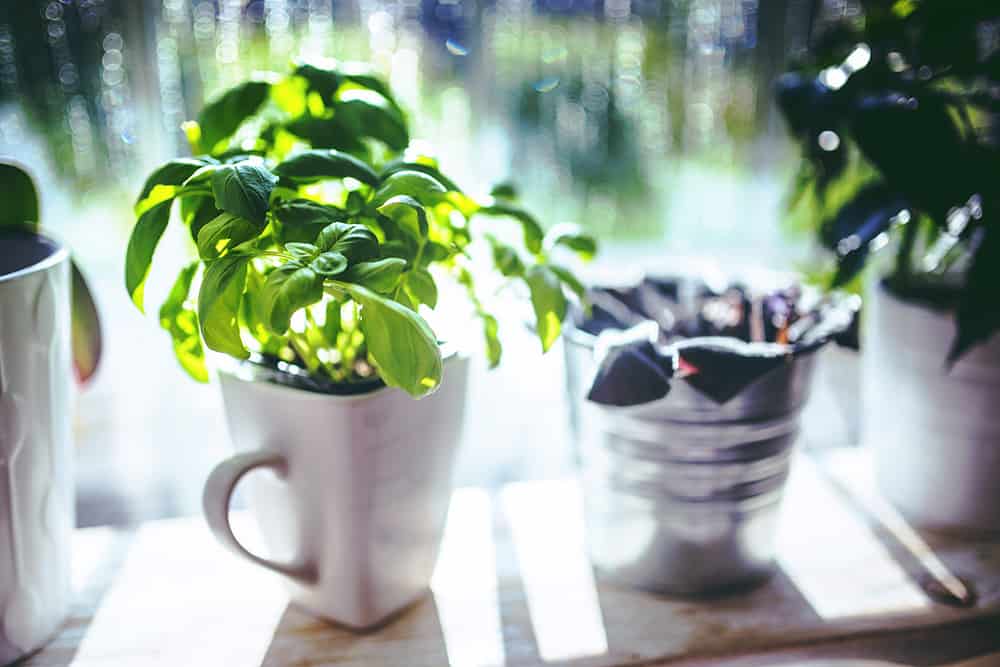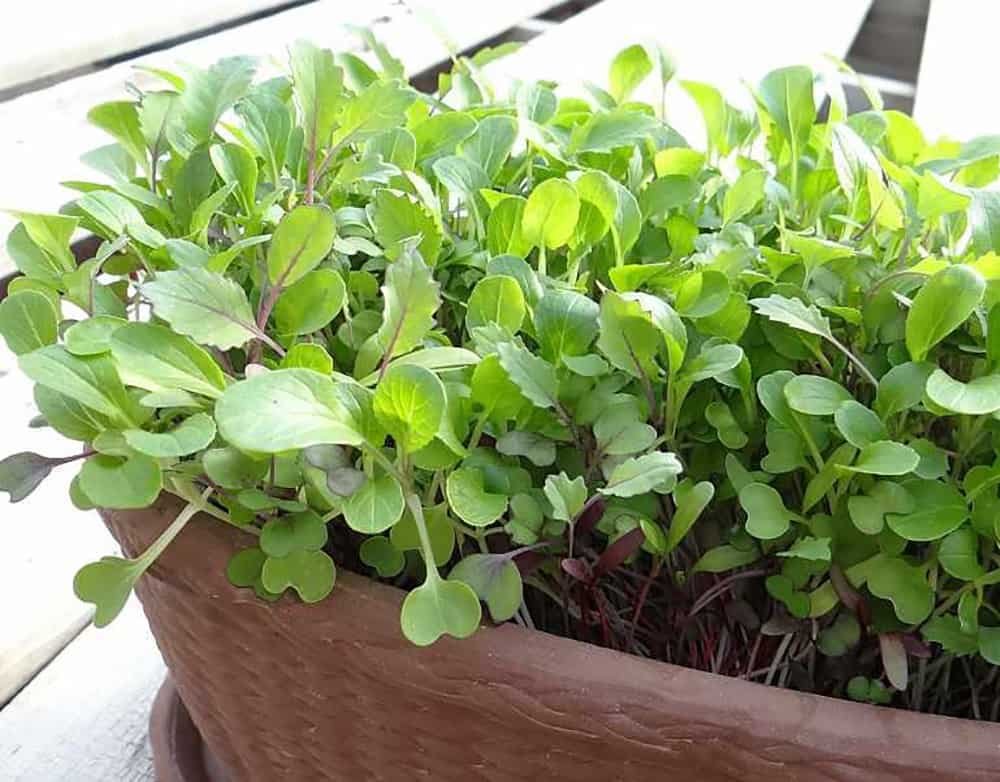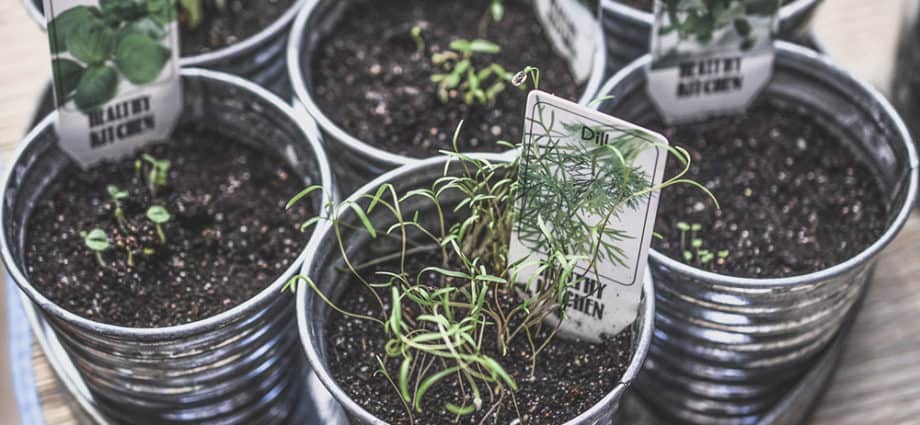When the days get shorter and the leaves change color, most gardeners have to put their veggies to bed for the winter. But you don’t have to say goodbye to fresh homegrown food just because there’s snow in your yard. Indoor gardening provides plenty of opportunities to grow no matter the temperature outside. If you’re new to gardening or want to try growing food indoors for the first time, read on.
With the proper grow lights, you can grow basically anything indoors. This list focuses on easy to grow foods that don’t require a lot of additional equipment. It’s perfect for beginners and urban gardeners who don’t have a lot of extra room in their apartment to grow food. These are also fun projects to do with kids during winter months when they’re cooped up indoors.

5 Best Foods to Grow Indoors in Winter
1. Herbs

Herbs are a classic plant for kitchen windowsill. Any chef knows why: having fresh herbs on hand is perfect for seasoning a variety of dishes. Plus it’s much cheaper and better quality than buying those little clamshells from the grocery store.
Some of the easiest herbs to grow indoors in winter months include chives, mint, parsley, basil, cilantro, thyme, and rosemary. Sunlight and consistent watering are key for success growing herbs in winter.
All you need is a sunny windowsill, some pots or a window box, seeds, and soil. If you want to make it even easier, use a hydroponic herb garden system to take care of lighting and watering your plants.
2. Mushrooms

I’ve always been a big fan of mushrooms, they’re so tasty in a variety of dishes and easy to prepare. But the idea of growing my own mushrooms seemed daunting until a friend of mine told me she grew mushrooms year-round in her apartment kitchen. Once you’re set up, it’s incredibly easy to grow mushrooms, they just require regular misting. No grow lights or sunny window needed.
If you’re a complete newbie, a mushroom cultivation kit is the easiest way to get started. (Advanced mushroom growers can purchase mushroom spawn and inoculate their own substrate.) You can easily grow tasty mushrooms like oyster, shiitake, and reishi any time of year.
We highly recommended the Back to Roots Organic Mushroom Farm Kit for beginners. Check out our review to see pictures and video of our experience.
3. Sprouts

Sprouts are often thought of as something you get at the salad bar, but they’re actually a nutritious superfood that’s incredibly easy to grow at home. If you eat sprouts often, you know that they can be a little expensive and got bad incredibly fast. If you grow them yourself, you can always have fresh sprouts available for salads, stir-fries, or snacks.
Sprouts are incredibly easy to grow–they’re basically the baby version of a plant. All you need are seeds, a container (like a mason jar, cotton bag, or a seed sprouter), and water. No soil is involved, so you can easily sprout seeds on a kitchen counter without taking up much space. It only takes a week to have sprouts ready to eat. Popular sprouts include peas, beans, broccoli, and spinach.
Learn more about growing sprouts at home.
4. Microgreens

Microgreens are the next step up from sprouts. Grown in a couple inches of soil, a microgreen is the toddler version of a plant. They require more time and effort to grow, but many people enjoy using the tender young greens in salads. They also have more nutrients that sprouts, so if you have the space and time it’s a great option.
Depending on what types of microgreens you’re growing, it usually takes 1 to 3 weeks to get a harvestable crop. To get started you’ll need a shallow tray (seed starting trays work well for this), organic seed starting soil, and sprouting seeds. You can easily buy seeds specifically for growing microgreens. I enjoy using a mixed seed blend so I get a nice variety of flavors in my salad.
Popular microgreens include peas, broccoli, radish, kale, mustard, and arugula.
5. Lettuce & Greens

If you’ve got the space and a sunny windowsill or two, you can grow your own fresh salad greens year round. Windowboxes work really well for growing all types of salad greens, as long as you avoid head lettuces which do not grow well indoors. The biggest challenge with growing greens in winter is sunlight. They need 12 hours of sunlight a day, so a south-facing window is best. Alternatively, supplemental grow lights will make it so you can grow lettuce anywhere in your home.
For indoor growing, buy seeds for varieties like Baby Oakleaf, Tom Thumb, and Black-Seeded Simpson or lower light varieties like Arctic King, Winter Marvel, and Winter Density. You can also try salad bar favorites like spinach, arugula, and mesclun. After about 3-4 weeks when the lettuce is 4″ tall it should be ready to harvest and enjoy.
Looking for more easy ways to grow food indoors? Check out these indoor hydroponic herb garden systems.
